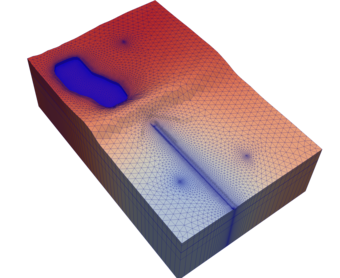1 !======================================================================
2 ! Fast in-line QSORT+INSERTION SORT
for Fortran.
3 ! Author: Joseph M. Krahn
4 ! FILE: qsort_inline.inc
7 ! Generate a custom array
sort procedure
for a specific type,
8 ! without the comparison-callback overhead of a
generic sort procedure.
9 ! This is essentially the same as an in-line optimization, which generally
10 ! is not feasible
for a library-based
generic sort procedure.
12 ! This implementation is as
generic as possible,
while avoiding the need
13 !
for a code pre-processor. The success of
this approach assumes that
14 !
internal procedures are always in-lined with optimized Fortran compilation.
17 ! This file
contains the
sort subroutine body. You must supply
18 ! an integer parameter QSORT_THRESHOLD, and
internal procedures:
20 ! logical
function lessThan(a,b)
21 ! subroutine SWAP(a,b)
22 ! subroutine RSHIFT(left,right)
27 ! Any user initialization code. This is needed because executable
28 ! statements cannot precede
this code, which begins with declarations.
29 ! In many cases,
this is just an empty procedure.
31 ! LOGICAL FUNCTION lessThan(a,b)
32 ! Return TRUE
if array member
'a' is less than array member
'b'.
33 ! Only a TRUE
value causes a change in
sort order. This minimizes data
34 ! manipulation, and maintains the original order
for values that are
35 ! equivalent by the
sort comparison. It also avoids the need to
36 ! distinguish equality from greater-than.
38 ! SUBROUTINE SWAP(A,B)
39 ! Swap array members
'a' and
'b'
41 ! SUBROUTINE RSHIFT(LEFT,RIGHT)
42 ! Perform a circular shift of array members LEFT through RIGHT,
43 ! shifting the element
at RIGHT back to the position
at LEFT.
46 ! The QSORT is used down to the QSORT_THRESHOLD
size sorted blocks.
47 ! Then insertion
sort is used
for the remainder, because it is faster
48 !
for small
sort ranges. The optimal
size is not critical. Most of
49 ! the benefit is in blocks of 8 or less, and values of 16 to 128
50 ! are generally about equal speed. However, the optimal
value
51 ! depends a lot on the hardware and the data being sorted, so
this
52 ! is left as a tunable parameter
for cases where there is an
53 ! effect on performance.
55 !---------------------------------------------------------------------
57 ! The procedure uses a optimized combination of QSORT and INSERTION
58 ! sorting. The algorithm is based on code used in GLIBC.
59 ! A stack is used in place of recursive calls. The stack
size must
60 ! be
at least as big as the number of bits in the largest array index.
62 ! Sorting vectors of a multidimensional allocatable array can be
63 ! VERY slow. In
this case, or with large derived types, it is better
64 ! to
sort a simple derived type of key/index pairs, then reorder
65 ! the actual data
using the sorted indices.
67 !---------------------------------------------------------------------
68 integer :: stack_top, right_size, left_size
69 integer :: mid, left, right, low, high
71 ! A stack of 32 can handle the entire extent of a 32-bit
72 ! index, so
this value is fixed. If you have 64-bit indexed
73 ! arrays, which might contain more than 2^32 elements,
this
74 ! should be
set to 64.
75 integer, parameter :: QSORT_STACK_SIZE = 64
76 type qsort_stack; integer :: low, high; end type
77 type(qsort_stack) :: stack(QSORT_STACK_SIZE)
81 if (arraySize > QSORT_THRESHOLD) then
89 if (lessThan (mid, low)) then
92 if (lessThan (high, mid)) then
94 if (lessThan (mid, low)) then
103 do while (lessThan (left, mid))
106 do while (lessThan (mid, right))
109 if (left < right) then
110 call SWAP(left,right)
111 if (mid == left) then
113 else if (mid == right) then
119 if (left == right) then
125 end do COLLAPSE_WALLS
127 ! Set up indices for the
next iteration.
128 ! Determine left and right partition sizes.
129 ! Defer partitions smaller than the QSORT_THRESHOLD.
130 ! If both partitions are significant,
131 !
push the larger one onto the stack.
132 right_size = right - low
133 left_size = high - left
134 if (right_size <= QSORT_THRESHOLD) then
135 if (left_size <= QSORT_THRESHOLD) then
136 ! Ignore both small partitions: Pop a partition or
exit.
137 if (stack_top<1)
exit QSORT_LOOP
138 low=stack(stack_top)%low; high=stack(stack_top)%high
139 stack_top=stack_top-1
141 ! Ignore small left partition.
144 else if (left_size <= QSORT_THRESHOLD) then
145 ! Ignore small right partition.
147 else if (right_size > left_size) then
148 ! Push larger left partition indices.
149 stack_top=stack_top+1
150 stack(stack_top)=qsort_stack(low,right)
153 ! Push larger right partition indices.
154 stack_top=stack_top+1
155 stack(stack_top)=qsort_stack(left,high)
159 end
if ! (arraySize > QSORT_THRESHOLD)
161 ! Sort the remaining small partitions
using insertion
sort,
162 ! which should be faster
for partitions smaller than the
163 ! appropriate QSORT_THRESHOLD.
165 ! First, find smallest element in first QSORT_THRESHOLD and
166 ! place it
at the array
's beginning. This places a lower
167 ! bound 'guard
' position, and speeds up the inner loop
168 ! below, because it will not need a lower-bound test.
172 ! left is the MIN_LOC index here:
174 do right = low+1, min(low+QSORT_THRESHOLD,high)
175 if (lessThan(right,left)) left=right
177 if (left/=low) call SWAP(left,low)
179 ! Insertion sort, from left to right.
180 ! (assuming that the left is the lowest numbered index)
182 do right = low+2,high
184 if (lessThan(right,left)) then
185 do while (lessThan(right,left-1))
188 call RSHIFT(left,right)
190 end do INSERTION_SORT
191 !--------------------------------------------------------------
subroutine next(this)
Increment the iterator to the next node.
class(*) function, pointer value(this)
Get the value the iterator is pointing at.
@ exit
particle exited a cell
logical function contains(this, key)
Boolean indicating if an item exists in the hashtable.
subroutine push(this, newValue)
integer(i4b) function size(this)
integer(i4b) function at(this, idx)
subroutine sort(this)
Sort the time selection in increasing order.

